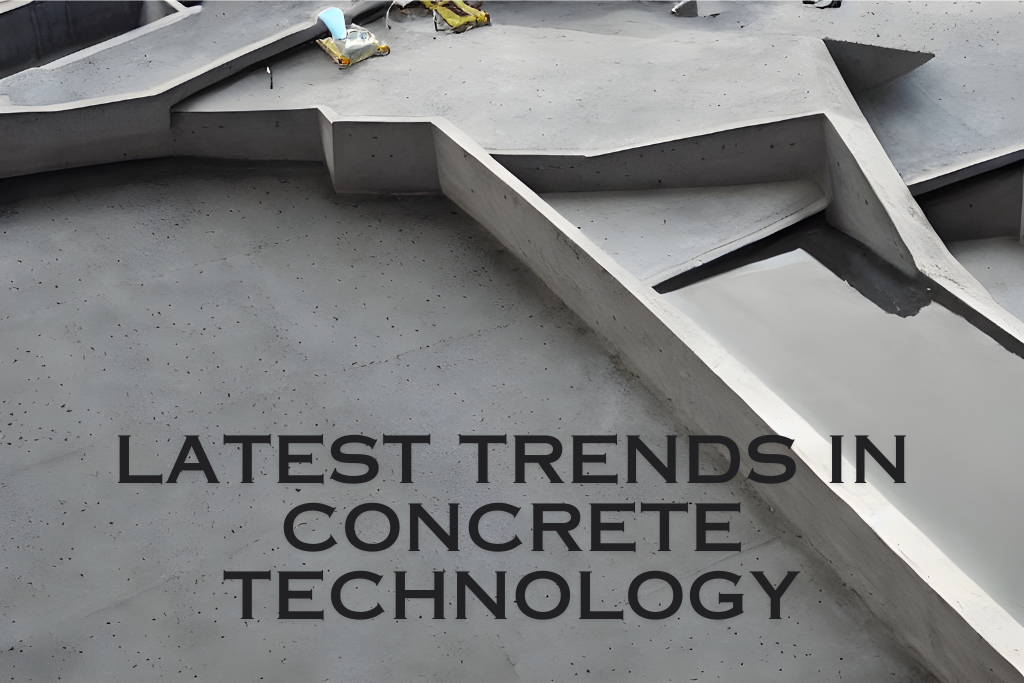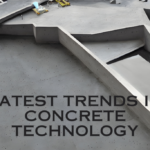Introduction:
Concrete, the cornerstone of modern construction, is undergoing a revolution every passing day. Advancements in technology are reshaping the way we perceive and utilize this as a fundamental building material. From sustainable practices to enhanced performance, the latest trends in concrete technology are pushing the boundaries of innovation. Let’s look into the exciting developments that are shaping the future of concrete.

Sustainable Concrete Solutions:
- With growing environmental concerns, as evident from adaptation latest practice of “Environmental Impact Assessment” a sustainable concrete solution have gained very prominence. One such innovation is the use of recycled materials, such as fly ash, slag, and recycled aggregates, in order to reduce the carbon footprint of concrete production.
- Additionally, the incorporation of supplementary cementitious materials (SCMs) like silica fume and metakaolin enhances durability and reduces greenhouse gas emissions during the manufacturing processes.
Self-Healing Concrete:
Self-healing concrete is a fascinating innovation in the field of construction materials. Essentially, it’s a type of concrete that has the ability to repair its own cracks autonomously without any human intervention. Here’s how it typically works:
- Microorganisms or bacteria: Some self-healing concrete formulations incorporate bacteria such as Bacillus subtilis or other microorganisms along with calcium lactate or other nutrients. These bacteria lie dormant within the concrete until cracks form.
- Triggering mechanism: When water enters through a crack in the concrete, it reactivates the dormant bacteria.
- Bacterial activity: Once activated, the bacteria produce calcium carbonate (limestone) as a byproduct of their metabolic processes.
- Filling cracks: The calcium carbonate fills the cracks, effectively sealing them and preventing further water ingress, which could potentially cause structural issues over time.
- Sealing and strengthening: As the cracks are filled with calcium carbonate, the concrete’s structural integrity is restored, helping to extend its lifespan.
Self-healing concrete has the potential to significantly reduce maintenance costs and increase the durability of concrete structures, making it an exciting development in the construction industry. However, it’s worth noting that the technology is still being refined and implemented on a larger scale, and its effectiveness can vary depending on factors such as the type of bacteria used, environmental conditions, and the size and severity of the cracks.
3D Printing in Concrete Construction:
- 3D printing has emerged as a game-changer in construction, offering unparalleled design freedom and efficiency. In concrete construction, 3D printing enables the fabrication of complex structures with precision and speed.
- This technology is revolutionizing the way we build, allowing architects and engineers to create innovative designs while minimizing material wastage.
High-Performance Concrete (HPC):
- High-performance concrete (HPC) offers superior strength, durability, and workability compared to conventional concrete mixes. Through the use of advanced admixtures, fibers, and optimized mix designs, HPC can withstand harsh environmental conditions and heavy loads.
- Applications of HPC range from high-rise buildings and bridges to offshore structures, where enhanced performance is paramount.
Digitalization and IoT Integration:
- The digitalization of construction processes, coupled with the integration of Internet of Things (IoT) technologies, is transforming the way we monitor and manage concrete structures.
- IoT sensors embedded in concrete can provide real-time data on temperature, moisture, and structural integrity, allowing for proactive maintenance and ensuring structural safety especially in humongous skyscrapers.
Carbon Capture and Utilization (CCU) in Concrete Production:
- Carbon capture and utilization (CCU) technologies are being explored to mitigate the environmental impact of concrete production. By capturing carbon dioxide emissions from industrial sources and incorporating them into concrete, CCU reduces the carbon footprint of construction projects.
- This approach not only helps in combating climate change but also enhances the performance of concrete by improving its compressive strength and durability.
Conclusion:
The future of concrete technology is bright, driven by innovation, sustainability, and digitalization. As we continue to stretch the boundaries of what is possible, the latest trends in concrete technology promise to revolutionize the construction industry, by offering solutions that are environmentally friendly, durable, and cost-effective. Adapting these advancements will not only shape our traditional but unconventional build but also pave the way for a more sustainable and resilient built environment.
Read also: Environmental Impact Assessment





